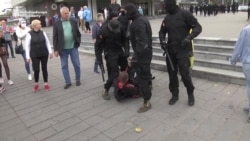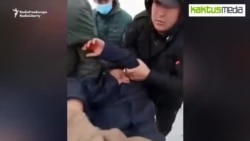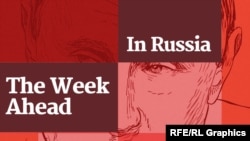
To receive Steve Gutterman's Week In Russia each week via e-mail, subscribe by clicking here.
In 2016, President Vladimir Putin said that “Russia’s borders don’t end anywhere.”
Four years later, the Kremlin is struggling to maintain influence amid a not-so-perfect storm of armed conflict and political upheaval in countries that are close to, but clearly beyond, the Russian frontier.
Almost 30 years after the collapse of the Soviet Union created 15 independent nations, the war in Nagorno-Karabakh and the tumult in Belarus and Kyrgyzstan could cost Moscow a big measure of the clout it still maintains in parts of the region Russian officials sometimes call the “near abroad” -- a term that is geographically accurate but also symbolic, implying a special interest and perhaps a sense of entitlement in Moscow when it comes to many of the other former Soviet republics.
The upheaval is a particularly stark test for Putin because Belarus, Kyrgyzstan, and Armenia -- which is fighting against Azerbaijan over Nagorno-Karabakh, a region in Azerbaijan that has been held by ethnic Armenian forces backed by Yerevan since a war that killed some 30,000 people halted with a shaky cease-fire in 1994 -- are about as close as it comes to being allies of Russia.
They are all members of the Collective Security Treaty Organization (CSTO), a military grouping, and of the Eurasian Economic Union, a customs and trade organization that observers say is the Kremlin’s answer to the European Union -- though resistance to Russian efforts to leave “Economic” out of the name revealed wariness among the others about being too closely linked to Moscow when it comes to geopolitics.
Russia has military bases in Armenia and Kyrgyzstan, and it has close defense ties with Belarus as well as a political partnership with Minsk, the Union State, though that exists largely on paper.
Over the past two years, Putin has pushed unsuccessfully to make those ties even tighter, meeting resistance from Alyaksandr Lukashenka, the authoritarian who has ruled Belarus since 1994.
With Lukashenka facing persistent protests and a major loss of legitimacy after claiming a landslide victory in an August 9 election that millions of Belarusians suspect was rigged, Russia now faces a dilemma that can be described in simple terms: stick with Lukashenka or dump him; support him or seek to muscle him out.
So far, Russia has supported him, and its backing may be the main reason he remains in power even as the postelection protests enter their third month. Why? Lukashenka’s sudden weakness hands Moscow leverage over him, and the Kremlin may hope to capitalize by strengthening its sway over Belarus. A $1.5 billion loan Putin promised in September looks like part of that effort.
'A Series Of Start-Ups'
But there may be at least one other reason Russia has decided to back Lukashenka for now: a lack of alternative figures for Moscow to turn to in Belarus. Picture Moscow as a mountain-climber finding no footholds on the left and right and taking the straightest way up the cliff face: a rope that is fraying and could break, in part due to the climber’s weight -- which is but for now the surest bet.
For now, but not forever: While it’s unclear what may happen in the coming months, it is hard to imagine Lukashenka hanging on and running for reelection again in 2025. And the longer the Kremlin shores him up, the more likely it is to do irreparable damage to its long-term prospects in Belarus by alienating its people.
“It’s quite risky for the Kremlin to lock onto Lukashenka,” Minsk-based political analyst Artsyom Shraybman told RFE/RL’s Russian Service in an interview published on October 8.
“I don’t rule out that in the future, if Lukashenka starts to resist Moscow’s desires…the Russian side will begin to test the ground --to look for other interlocutors,” Shraybman said.
The Kremlin might now approach Belarusian politics like a venture capitalist supporting “a series of start-ups: You launch a dozen initiatives -- let’s try to talk with these officials, maybe with these military men -- and you see which one hits the jackpot,” he said. “This may already be happening.”
The reason for Russia’s lack of purchase up to now is twofold at least, Shraybman suggested. For one thing, Lukashenka’s main foes are not anti-Moscow, but they are not advocates of closer integration with Russia -- and those who are not in jail are in exile in the West, where they are forging ties with governments that no longer recognize the Belarusian strongman as president.
Meanwhile, amid pressure from Putin for closer integration in recent years, Lukashenka has purged officials seen as particularly sympathetic to Russia from government structures.
“Lukashenka has blocked any possible separate negotiations with Moscow by his officials,” has “pushed out people…who might be acceptable for Moscow,” and has “never permitted a serous pro-Russian opposition to emerge in Belarus,” Shraybman said. “This is a conscious effort to remove Moscow’s potential alternative interlocutors.”
Fast-Paced Events
For all the differences between the unrest in Belarus and the upheaval that has shaken Kyrgyzstan in the wake of its own disputed election, the Kremlin could face similar challenges there: a search for footholds on a shifting surface, and the risk of hitching its horse to the wrong wagon.
But in Kyrgyzstan, Moscow may have to scramble faster than in Belarus.
President Sooronbai Jeenbekov, who has warm relations with Russia, was under pressure and appeared to be losing influence fast after protesters chased his cabinet from power less than 48 hours after polls closed in October 4 parliamentary elections marred by evidence of vote-buying and other fraud.
The other big challenge for Moscow that emerged abruptly near its borders is in the South Caucasus, where the simmering conflict over Nagorno-Karabakh erupted into the deadliest fighting in years, testing Russia’s relations with Armenia and Azerbaijan and -- with Turkey taking a more assertive stance than before in its backing for Baku -- threatening Russia with an embarrassing loss of influence in the region.
New Status Quo?
Russia’s inability to halt the new fighting so far -- either in its own or jointly with the United States and France, partners in the international mediating group that has been trying unsuccessfully to guide Armenia and Azerbaijan to a resolution since the 1990s -- has already cost it some clout. Moves late this week to step up its diplomatic efforts suggest Moscow realizes that.
And analysts have long maintained that Russia, which has close ties with both countries and has armed both sides, has been happy to let the dispute over Nagorno-Karabakh continue without major escalations -- a status quo that has been torn apart by the current escalation.
That status-quo is unlikely to return, several analysts have said, some predicting that any agreement to halt the current fighting or draw closer to a resolution would probably leave Azerbaijan in control of more territory than it held on September 26. Since the cease-fire in 1994, ethnic Armenian forces have controlled Nagorno-Karabakh and a swath of territory around it, part of which borders Armenia.
Russia’s aims are simple enough: It wants to maintain as much influence as possible in the South Caucasus, which lie between the Black and Caspian seas and border Russia, Turkey, and Iran. But it is juggling an array of interests related to security, arms sales, and geopolitics, as well as to relations with Armenia, Azerbaijan, and Turkey, among others, and its calculations about the conflict could change as the situation shifts.
Remarks by a range of analysts suggest that at this point, the best the Kremlin can hope for could be a situation in which Moscow plays a key role in halting hostilities and Azerbaijan controls more land than it did before -- but not enough to make Turkey look much stronger or Russia much weaker.
Enough, also, to put domestic pressure on Armenian Prime Minister Nikol Pashinian, whose rise to power as the leader of large street protests that pushed out an old-guard government in 2018 makes him an uncomfortable figure for Putin despite his pledges to maintain close ties with Russia. But not enough to make Moscow look like it has badly failed its fellow CSTO member, the host of its biggest military base abroad, and the closest thing it has to an ally in the South Caucasus.












